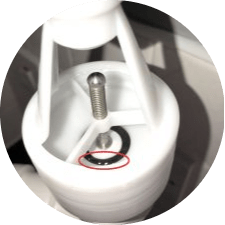There are various ways that an installer can achieve compliance
but what is the most cost-effective?
The diagram below sets out some typical compliant solutions with associated costs;

Boiler and Unvented Water Heater Solutions
Traditional Solutions
Traditionally an installer can run the pressure relief valve discharge pipework to an outside wall and terminate in a conspicuous and safe place. This is suitable if the appliance PRV drain has access to an outside wall and there is a means of discharging in a safe and conspicuous manner. The installer is faced with having to drill through the fabric of the building, sleeve and seal the tube and that can get more problematic if the point of discharge is at height (for instance a loft installation). The discharge would also then need to be brought down to a lower level to make it visible when diagnosing issues – such as an apartment in a multi-story application.
Hybrid Solution
The use of a standard internal tundish (with air break to drain) located in a conspicuous but safe location internally, then discharge out through the outside wall to a safe place (Number 5 above) brings the point of diagnosis visibility to the internal space but with regards to lofts and multi-story applications will have issues with working at height.
Multiple Product Solution
Going fully internal, utilizing a standard tundish (with air break to drain) and connect that to a device that can act as a (mechanical) odour trap (Numbers 2 & 4 above) and then connect to a local foul waste or soil pipe (depending on application and regulation requirements) has become an accepted and viable method but it does require two products with all the associated fittings required to connect them and especially in an under-counter installation where space and height are critical, it can be problematical.
Single Product Solution – The hotun Solution
hotun was specifically designed to be a single product solution for this problem! It is the original and pioneering product that has transformed this PRV installation method.
Specifically designed for internal PRV discharge applications, the hotun dry trap tundish provides a simple, cost-effective, and compliant solution.
hotun is the pioneering, original and ONLY dry trap tundish on the market that provides TWO vital advantages for the installer.
1 – Compliant at point of installation


2 – Visibility at the point of diagnosis

The hotun dry trap tundish provides easy visibility of any water having been discharged even after the PRV has stopped dripping – no other dry trap tundish offers that vital feature!
hotun – It’s not just a tundish
Get In Touch
Registered Address
RA Tech UK Ltd
6 Nottingham Road
Long Eaton, Nottingham, UK
T: 01332 702678
E: info@ratechuk.co.uk
HOTUN – THE SIMPLE SOLUTION
Enquire Now
